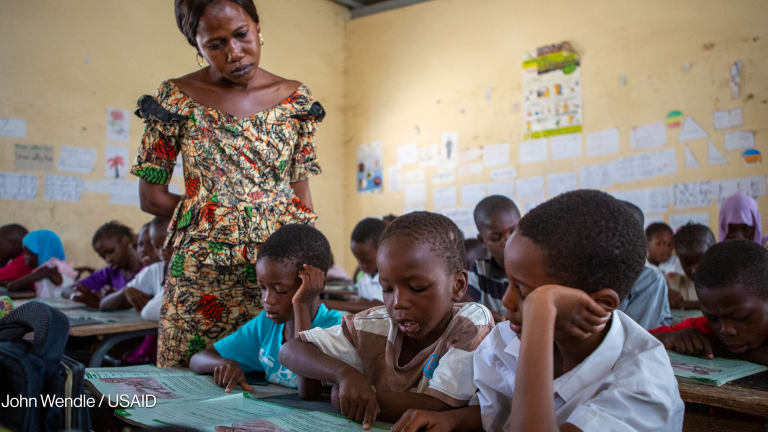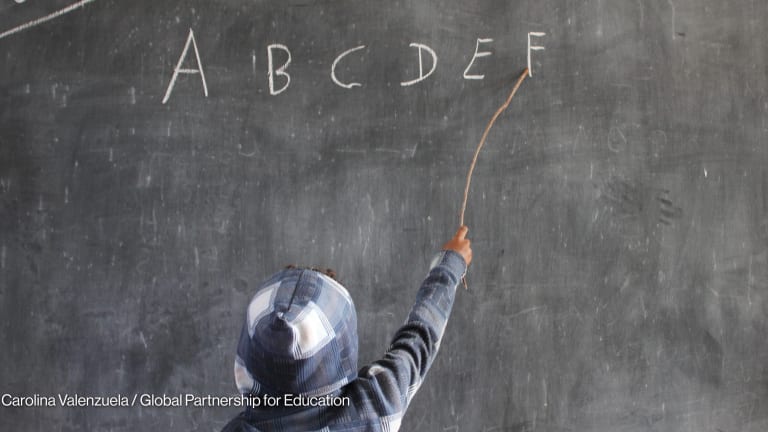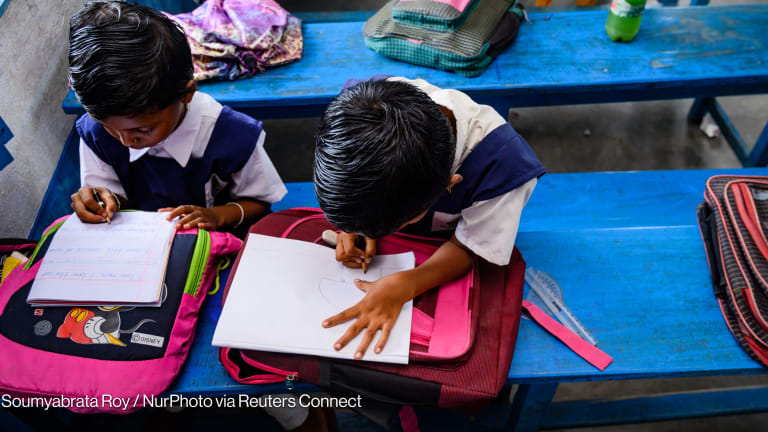
Now in its 15th year, the Global Partnership for Education is asking donors to open their wallets once again for the next replenishment round, aiming to raise $3.1 billion over three years.
Devex caught up with Julia Gillard, chair of the GPE — a partnership and funding platform that aims to strengthen education systems in developing countries — to find out more about the in-country results it has seen, the future of global aid spending in Europe and the United States, where the fund stands on issues such as education quality and testing, and private versus public schools.
The former Australian prime minister was in Washington, D.C., last week to raise funds for the 2018-2020 replenishment round, and to attend the World Bank and IMF spring meetings, during which she took part in a session hosted by the Center for Global Development on financing education.
Launched in 2002, the GPE provides grants and technical assistance to developing country governments to improve education plans and support their implementation. Run out of the World Bank, which hosts the secretariat and supervises the majority of GPE grants, the fund has raised nearly $4.7 billion to date, which has been dispersed to more than 60 developing countries.
Should 10 percent of UK aid go to education?
The United Kingdom parliament's International Development Committee today threw its support behind dedicating 10 percent of the annual aid budget to education.
Gillard faces a tough sell for the next round however, at a time when aid budgets are facing higher scrutiny, particularly in the United Kingdom, which is currently the fund’s largest donor. The U.K. had contributed $1 billion as of the beginning of 2017, almost double as much as the next highest contributor, the Netherlands, according to GPE data. The U.S. accounts for nearly $200 million of funding.
Global education spending has also been declining in recent years — education’s share of official development assistance has fallen from 13 to 10 percent since 2002, and among multilateral donors, the education pot declined from 10 to 7 percent over the past decade, according to Education Commission figures.
Devex sat down with Gillard to find out more. The conversation has been edited for length and clarity.
What case are you making to donors for the next GPE replenishment?
“Many people, too, would point out that the ‘Holy Grail’ of development now is girls’ education.”
— Julia Gillard, chair of the Global Partnership for EducationMany people make the point that the biggest source of financing for education in developing countries is actually their own financing — domestic resource mobilization — and our partner countries have progressed more than three times as fast as the developing country average rate of increase in domestic expenditure.
Many people, too, would point out that the “Holy Grail” of development now is girls’ education because we know what great spin off advantages that has for health, peace and prosperity for the next generations. The primary school completion rate in the GPE countries has moved from 56 percent in 2002 to 71 percent in 2014 — so that’s a big improvement, but not enough.
Other figures include 64 million more children in primary school in 2014 compared with 2002, overall completion rates up by 10 percent, and lower-secondary school completion rates increased by 12 percent.
We want to build on those past successes with this new replenishment. We will be asking the international community to replenish us at a rate of $3.1 billion for the years 2018 to 2020. We will then be aiming to grow, in line with the Education Commission recommendation that the GPE should build from being a $2 billion a year fund to being a $4 billion a year fund between 2020 and 2030.
What we are aiming to do with these funds over the next three years is to see 19 million additional children finishing primary school. Almost 11 million of them will be in fragile and conflict-affected places. We are also aiming for an additional 6.6 million children to complete secondary school.
How will the GPE do this?
The GPE’s model is about strengthening the education system, improving quality and increasing equity and inclusion for the most at-risk groups. Sixty percent of the GPE’s spending is in conflict-affected and fragile countries, where about two-thirds of the world’s out-of-school children live. Furthermore, 63 percent of child refugees are currently in GPE partner countries.
The GPE is a country-led model, and the way we drive change is that we mobilize technical expertise and inclusive discussion to properly plan education systems. We structure a results-based component to the grants to ensure the focus is around learning and equity, and we require there to be data-based strategies. Everything we do is to achieve high-quality and universal education.
Many European countries and also the U.S. are considering scaling back their aid budgets. How might this affect the GPE’s fundraising strategy and effectiveness?
“We are out talking to traditional donors but also looking beyond. We have opened up a dialogue with China.”
—We are out talking to traditional donors but also looking beyond. We have opened up a dialogue with China, and China sent a high-level team to watch the December board meeting we had in Cambodia. We are prepared to take the time necessary to work on those very new relationships, but we will be advocating for new donors, as well as step-ups from traditional donors.
Many traditional donors can and should do more in education — the Education Commission report said that 15 percent of ODA should be going to education and that’s a target we endorse. We’ve seen many donors in Europe take a step back in the wake of the global financial crisis, but we will be looking to a number of those donors to step back up.
The U.K. and the European Union are our biggest supporters, but it’s too early to speculate about what mooted cuts in the U.K. and the U.S. will mean for the GPE. The U.K. has pledged a total of 300 million pounds ($387 million) for the current replenishment period ending 2018.
UK snap election: Are aid commitments at risk?
As the U.K. heads for a snap election on June 8, concerns are being raised that the government's legal commitment to spend 0.7 percent of gross national income on foreign aid is looking vulnerable.
Generally, in respect to the U.K., one of Prime Minister Theresa May’s big themes since taking office was that she did want the U.K.’s voice to be strong in the world, and for the U.K. to be out there and recognised for its contribution to the global community.
Around the world, the U.K. is very strongly recognized for its commitment to spending 0.7 percent of its gross national income on aid every year, and for what it’s been prepared to do multilaterally, through the GPE, and bilaterally on education, particularly girls’ education.
What is the GPE’s position on public versus private education? Liberia, a GPE recipient, provoked controversy last year when it revealed plans to outsource primary education, including to private school chain Bridge International Academies. As Devex reported, the Ugandan government has threatened to shut down Bridge schools for allegedly failing to meet national education standards.
“Ours is a country-led development model so we don’t have people steam out of the secretariat in Washington, D.C., saying, ‘have I got an education plan for you.’”
—There’s much discussion. From a GPE perspective, ours is a country-led development model so we don’t have people steam out of the secretariat in Washington, D.C., saying “have I got an education plan for you.” If we did that, by definition, it wouldn’t work because contexts and needs are different — so in our model, we work with the government in an inclusive process and with civil society and other donors and actors to get a robust plan that works for that country.
Some countries will choose to have not-for-profit schools as part of their education system, some will choose to have for-profit schools, some might have a public-private partnership, such as the one in Liberia. We don’t dictate those choices — but schooling has to be for everyone. There can’t be barriers of cost that prevent kids from going to school.
We’ve been hearing a lot of discussion recently about the ‘learning crisis’ — that quality of education is just as important as access to learning. What does the GPE do to ensure quality?
Our system strengthening model is about access — because there are still kids out of school — but it’s also about quality improvement.
A lot of dialogue is about efficiency of the spend, in terms of learning outcomes, and also about avoiding repetition rates which mean that kids spend more time in school to get to the same quality benchmarks.
So when we’re talking about planning the system, we have a focus on learning and learning outcomes, on data, and on equity and inclusion of those most at risk. We also include a results-based component, so 30 percent of our large grants depends on countries reaching performance measures they’ve agreed with us. That’s one way of making sure there is a big spotlight on quality.
Does quality just mean a lot of testing?
We know there’s been recent public policy debate about testing — but my perception of the countries I’ve travelled to is that they are really grappling with different challenges. It’s not kids being tested too frequently [that’s the challenge]; it’s the far more fundamental problems, and we are mobilizing funds through our planning model to try and make a difference to those very big challenges.
Testing is a means to an end — the purpose of testing and assessment is to see where an individual child is at, and what next needs to be done to improve their education. It’s not something to be frightened of — it’s a tool to be used to enhance quality.
What are some of the challenges in running multi-stakeholder partnerships like the GPE?
There is power in the partnership, which doesn’t mean every conversation is an easy one — we have so many different groups represented around the board table that inevitably there are going to be different views on some issues.
However, because these people care about the outcomes for children, and because they’ve got to know each other through the process of working with the partnership, the power comes when they bring those differences to the table and we work through and resolve them. I’ve seen that, time after time, chairing the board: What felt like it might be an intractable dispute when people sat down, actually becomes manageable through the process of discussion.
Read more international development news online, and subscribe to The Development Newswire to receive the latest from the world’s leading donors and decision-makers — emailed to you free every business day.








